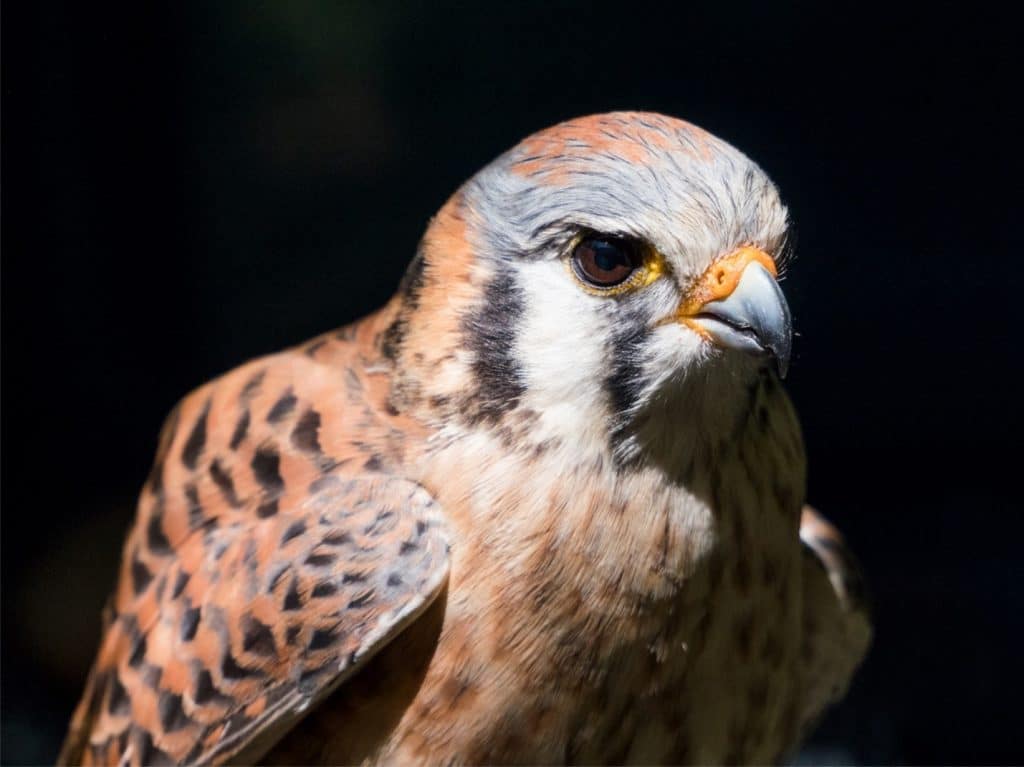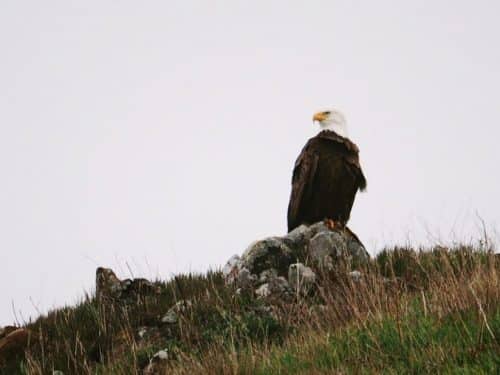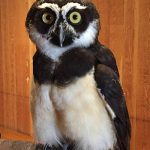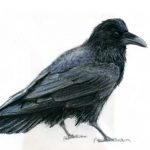Blog
Raptor Power: Discover Birds of Prey
In honor of Raptor Power Day, we share photos, fun facts and quirky attributes of different kinds of raptors found in California.
As Raptor Power Day approaches, have you wondered what makes raptors unique? Birds of prey, also known as raptors, are predatory birds with special adaptations to help them survive in the wild. All birds of prey have curved, hooked beaks, strong sharp talons and are able to kill and carry away their prey. There are 6 main types of raptors found in California: Hawks, Falcons, Kites, Osprey, Owls and Eagles. Over the next two weeks we will dive deep into what makes these birds unique. Pictured below is one of the most common raptors in North America, the red-tailed hawk. Red-tailed hawks are in the buteo family, which are hawks with big, broad wings adapted for soaring and flying long distances. You have a high chance of spotting one while on a trip to Coyote Point Park.
Have you ever heard the distinctive ‘kee-ah’ of a hawk before? You may have been in the presence of the Red-shouldered hawk. Red-shouldered hawks are a medium-sized bird of prey in the buteo family, often found perched in a tree looking for food. Red shouldered hawks are named after the rusty color found along their wings and body. These hawks can often be heard in deciduous or coniferous forests, especially near water by their repetitive kee-ah sound. Their call can be used to attract mates in late spring through early summer.
A northern harrier extends her wings, quickly turning her body while scouting for food. Northern harrier hawks, also known as marsh hawks can often be seen flying low over marshes or open grasslands in search of food. When this hawk sees a potential meal they can quickly turn their wings and shift their body towards their prey and attack from above using their strong, sharp talons. Female and juvenile harriers are brown in color while mature males are grey. Northern harriers are easily recognizable by being a low flying bird with a white band at the base of their long tail. Harriers also have a facial disk similar to those found on owls to help focus in on sounds.
Cooper’s hawks are in the accipiter family of hawks found in California, along with goshawks and the similar looking but smaller, sharp shinned hawk. Accipiters have adapted to live and hunt and in forested areas. Their long tails and short rounded wings allow them to fly fast and move easily through the trees. Cooper’s hawks can often be found perched in trees or on telephone wires found in heavy wooded areas and big cities like San Francisco.
Two white tailed kites battle overhead in the Palo Alto Baylands, CA. During mating season it isn’t uncommon to hear the commotion and even see two male kites battling for a female. The birds will fly around and attack each other, talons first. When one male retreats, the other male will form a monogamous bond with the female. While courting, the male may pass food to the female while in flight. The female will fly below the male then pull up towards him to grab the food with her talons in a fantastic aerial display.
How do falcons differ from hawks? Falcons differ from hawks because falcons do not have a brow ridge to keep sunlight out of their eyes. Instead falcons have dark areas below their eyes often called a mustache. Falcons also have pointed boom-a-rang shaped wings which are excellent at allowing the bird to accelerate quickly through the air in short bursts. Pictured is an American Kestrel, the smallest and most common falcon in North America. American kestrels can fly between 25-45 miles per hour and often catches prey, like dragonflies or smaller birds mid air!
What’s the fastest animal on Earth? Did you guess the peregrine falcon? If you did, you are correct! People often think cheetahs are the fastest animal on earth. Although cheetahs are the fastest land animal running at speeds up to 75mph, Peregrine falcons are the fastest animal on our planet. Peregrine falcons can fly at speeds of over 200mph. Even more impressive, these birds fly straight into their prey at these speeds, killing their meal instantly. Pictured is Horus, our peregrine falcon. Horus is blind in his right eye which doesn’t allow him to have good depth perception. His blindness doesn’t allow him to survive in the wild. Why is this? As you can imagine, a bird flying at speeds over 200mph really needs to know how far away or close something is to be able to survive on their own.
Osprey are large raptors who mostly eat fish. Unlike bald eagles who swiftly fly over a body of water to gracefully snatch out a fish, osprey dive talons first into the water to catch a fish. Their powerful wings have adapted to pull themselves quickly out of the water with fish in tow. Osprey can sometimes be seen flying around in circles “showing off” their catch before landing to eat. When visiting CuriOdyssey, keep your eyes and ears open. If you’re lucky enough you might just see or hear our resident Ospreys flying above or perched on a tree near the water.
When most people think of owls, they think of an intelligent bird who wakes and hunts in the night. In reality, owls aren’t as intelligent as they are portrayed. Their small skull is taken up mostly by their large eyes, leaving little space for much else including their brain. Burrowing owls, like the one pictured here are diurnal, meaning they are awake and hunt during the day. Burrowing owls live in holes on the ground called burrows, where they can hide from predators. If a predator like a badger comes too close to their burrow, as a last ditch effort the burrowing owl can screech, which sounds very similar to a rattlesnake’s rattle, hopefully discouraging the badger to come any closer. Come to CuriOdyssey and meet our burrowing owls Woody and Pigwidgeon in our walk-through aviary.
The great horned owl is one of the most recognizable owls in the United States. They are a fierce raptor with almost silent flight. Being nocturnal, they fly around at night in search of prey. Their ear holes are asymmetrical, one pointing up while the other points down. This enables them to pinpoint sounds from above and below. Great horned owls can also turn their heads 270 degrees. Their eyes are so big, there is no room in their eye sockets for muscles, so they are unable to move their eyeballs. Great horned owls are strong, hardy birds known to take sleeping hawks from their nests, or skunks off the ground. Since great horned owls cannot smell, a skunks smelly defense has little to no effect at discouraging this owl.
Two Golden Eagles perch on an old oak tree overlooking the mountains in Sunol, having a rest between looking for a meal. Sunol has a lot of ground squirrels and it’s one of these birds favorite treats! Eagles can be found flying high, circling from above, looking for prey. When they spot something on the ground like a squirrel, jack rabbit or even a fox, eagles dive at an angle, flying at speeds up to 200mph. They swoop down and grab their prey in their talons and swiftly fly away. It isn’t uncommon to see a mob of ravens chasing after an eagle to try to steal the food away.
Imagine a Bald eagle in the wild. What comes to mind? Do you imagine the bird flying low over a lake with a fish in its talons, maybe in Alaska? Or do you imagine a bird sitting on a rock on top of a hill in San Jose, CA? Bald eagles eat more than just fish. They have been observed catching prey like ground squirrels right here in the Bay Area. Currently there are Bald eagles nesting in Morgan Hill, Sawyer creek reservoir in San Mateo, and Lake Chabot in Castro Valley. A couple years ago a juvenile Bald eagle was spotted right here at Coyote Point Park, until it was chased away by ravens.
Vultures and Condors are vital to keeping our wild areas clean and help stop the spread of diseases. Vultures and condors both eat dead, rotting animals also called carrion. What would you imagine a world would look and smell like if we didn’t have vultures and condors to be nature’s waste managers? Turkey vultures like the one pictured are very commonly seen in California and can be identified by the “V” shape their wings make in flight, and the lighter color of their feathers under their wings. Condors on the other hand are far rarer than turkey vultures to see, and can only be seen in a few places in California and Arizona. The California Condor have made a remarkable comeback from the brink of extinction with help from conservationists and are steadily bringing their numbers back to healthy levels. Although, much work is still needed to take North America’s largest bird off the endangered species list. Go to your local library, or look online to see why these magnificent birds are still at risk, and what you can do to help!
Photo courtesy of our Turkey Vulture information page here.
Birds of prey play an important role on our planet. They help keep rodent populations down, are prey for other animals, help clean the environment, and are a joy to see when out on a hike. Like most other birds in the United States birds of prey are protected by the Migratory Bird Act. When out on a hike, it can be tempting to take a feather you find but doing so can be illegal. Please help keep these birds safe by spreading the knowledge you’ve gained from these posts and look up other ways to keep birds in your neighborhood safe, like not using rodenticides, covering glass windows with bird detractors, and keeping any bird parts you might find in the wild, where you found them!
Written and Illustrated by CuriOdyssey Science Educator Kevin Shoban.
Join the CuriOdyssey Community
LOCATION
1651 Coyote Point Drive
San Mateo, CA 94401
Ohlone Land Acknowledgement
650-342-7755
[email protected]
CuriOdyssey is a 501(c)(3) nonprofit, Tax ID 94-1262434
















